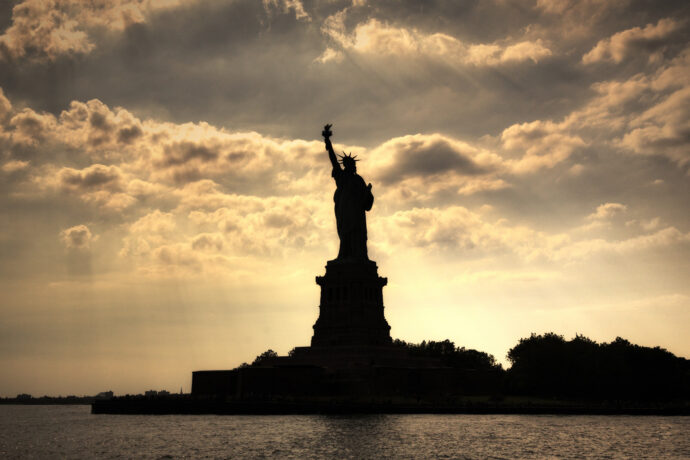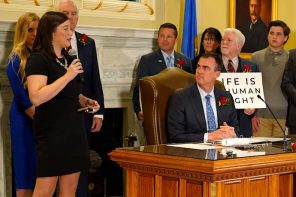The Trump administration has an image problem, not merely a problem of leaks (where Trump’s obsession with his own person image, as in the recently released transcripts of phone calls with Mexico and Australia, is all too apparent as a dominant and guiding focus) or a problem with those picked to actually “communicate” on behalf of the White House (from a Press Secretary who hid “among” bushes and banned cameras from press conferences to a Director of Communications who, in the early and yet also late days of his short-lived job accused one upper administration official of psychological pathology and attributed to another freakish autoerotic skills). The administration now has a problem of having fallen on the wrong side of a central image of American civil religion.
Ronald Reagan called her “everybody’s gal.” In wartimes she’s carried a sword, placed an urgent phone call for financial help, and even scolded her citizenry. As a mascot for our country, she’s been given the face of a skull on the streets of Tehran and been beheaded by Trump in a famous Der Spiegel cover from earlier this year. In the religious and cultural imagination of America, she’s been denounced as a demonic idol, revered as a Wiccan goddess, reimagined as a Christian symbol holding aloft a cross (because, America) and as a superhero whose torch fires energy beams (because, America!). She’s used to the limelight and unaccustomed to losing confrontations in the US media.
So it was further bad news for the beleaguered Trump administration when it found itself in a fight with public beliefs about the statue last week. At a briefing touting a new bill restricting immigration, CNN’s Jim Acosta asked how the bill fit with “American tradition,” and quoting from Emma Lazarus’s sonnet, “The New Colossus,” the poem on the pedestal on which Liberty Enlightening the World, better known as the Statue of Liberty, stands.
Acosta’s question was either an act of a provocateur, laying a trap in which he knew Miller would spectacularly stumble, or an earnest expression of contemporary patriotic angst. He either cited the Statue of Liberty because he felt confident the Trump administration would offer the awful optics of assaulting that lady, too, or because—as one of the central shared symbols of our national identity, a true icon of the “American tradition” of which he spoke—the Mother of Exiles represents American ideals when it comes to immigration.
Ideals matter. Indeed, when the fuzzy category of “religion” gets used as a lens to help understand the dynamics at play in national identity, in patriotism, ideals and symbols are at the foreground. Talk about “civil religion” seeks to make sense of the way that idealized narratives of history, articulation of idealized values, the symbols representing and the rituals enacting such ideals are used to make meaning of the project of the state. The nation becomes a community by becoming a set of ideals.
Ideals are not the same as policy proposals, and they are certainly not synonymous with history. This was Miller’s first mistake, turning condescendingly pedantic (not a much-loved trait in America) and lecturing Acosta on what Acosta—and, according to Acosta, a great many Americans—believe. History was rallied to counter faith. “I don’t want to get off unto a whole thing about history here,” Miller said, followed by an originalist theory that separated the statue and its meaning from the text of the poem, added, along with the pedestal, several years later.
The lady, in Miller’s reading, means the example American freedom offers to the world; the beacon is not a welcome (that “cosmopolitan” sentiment, to use Miller’s snide euphemism, is just a partisan stance).
This is doubly dangerous ground. First, American history has so spectacularly clashed with American ideals (see: slavery). Second, by dismissing Acosta’s reading of Lady Liberty as partisan, Miller switches the register of language used, from that of religious discourse—in which the statue has an eternal meaning, “has always” meant this, Acosta pleads, citing “what the country has always thought of”) to a drily historical material reading where there is no eternal, united, ideal of America, just differing opinions, shifting policies. Acosta’s question introduced American civil religion to the briefing, to which the Trump administration official shot it down as “ahistorical.”
Another fail for the White House, even if Miller’s facts were right and even if Acosta’s accosting of him went beyond the standard protocol of a journalistic Q&A. Miller even oddly opted to utter the word “racist,” as part of a denial of the bill being that, succeeding only in sounding suspicious, like the motorist at the traffic stop quick to volunteer that he’s not drunk.
Reactions across the globe—and across the political spectrum—took note of Miller’s misstep, either explicitly evoking the language of religion (“Is Nothing Sacred?” asked the headline in the Guardian, which began with the ominous line: “The surest mark of regime change is when they start attacking the statues.”) or implicitly reiterating the civil faith Acosta bore witness to by running poignant pictures of Lady Liberty as a manifestation of shared American values of inclusion and possibility.
David Green in Haaretz wrote that the “extemporaneous remarks” in reaction to the question about the poem “betray the real attitude of both Miller and the administration he represents: a closing of the door, not only on entry to America, but to access for those already in the country to all the things that the United States has symbolized to both its citizens and those outside it, for at least a century.”
The National Review, under the headline “On Immigration, Poetry Isn’t Policy, But Poetry Matters,” lamented that Miller hadn’t responded with feelings as well as facts. A nativist sacred narrative—one focusing on “compassion for struggling Americans trying to make their way in a changing economy” could counter the famous words of Lazarus. Lamentably for conservatives, Miller didn’t go there.
“Statue of arrogance,” is how a barbed statement from the Anne Frank Center describes his dismissal of the poem. Lazarus’s biographer weighed in on the scene, describing Miller as “a Trump apologist telling a reporter that a revered American poem must be dismissed on the ground that it’s a fake law (Miller baited Acosta repeatedly about different moments in immigration history, asking ‘is that violating or not violating the Statue of Liberty law of the land?’)” Acosta promptly tweeted the text of the poem, and Newsweek published it. “A mighty woman with a torch her name / Mother of Exiles. From her beacon-hand / Glows world-wide welcome.”
More eloquent than a pre-dawn tweetstorm, more memorable than the Orwellian coinages of “alt-fact” and “post-truth,” the poem is unshakably associated with the statue on the public imagination. (If Miller were really interested in originalism, he might have noted, as the Smithsonian did a few years back, that the lady’s original design had her wearing a veil, as an Egyptian peasant woman, and her intended function was to serve as a lighthouse on the Suez). The poem’s power, too, comes in the fact that, like the mute statue to which it is paired, it can be read across the partisan divide, a paean alternately (or simultaneously!) to American’s exceptional greatness as the result of compassion and generosity as well as the result of an economy characterized by opportunity, where the poor of the world will be limited in their achievements only by the will with which they tug at their own bootstraps. And, yes, as Miller would say, both of these idealized conceptions of the nation are “ahistorical.”
The religious imagination focuses beyond history for a reason: history is often ugly, cruel, a theater of the worst and most petty aspects of human nature. Looking beyond this, investing faith in our desires for a better world, striving to live in keeping with a set of radically ahistorical ideals, makes life a meaningful struggle. Such faith, on the level of the state, turns the practices of democratic citizenship into a quest for “a more perfect union,” a society synonymous with the ideals of plurality, equality, justice, and freedom.
In a time when our highest elected officials seem resolutely—almost unbelievably—crass and self-centered, we need, all the more, to focus on our shared ideals and the symbols—like Lady Liberty—that represent them.





